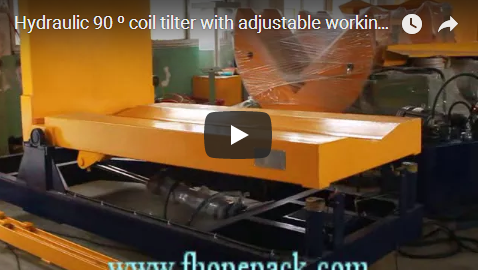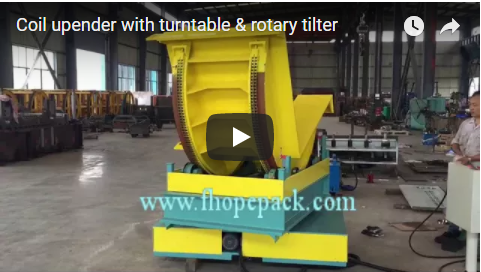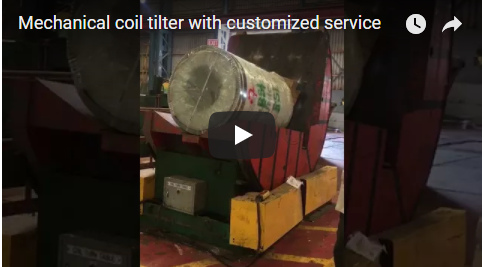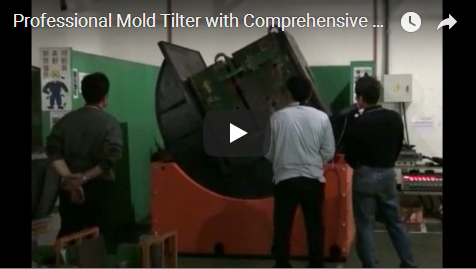Optimizing Heavy Material Handling: Precision and Safety with Hydraulic Tilters and Upenders
Handling heavy, bulky, or awkwardly shaped materials like steel coils, large molds, dies, paper rolls, or spools presents significant challenges in many industrial environments. Manual handling is often impractical and unsafe, while inefficient mechanical methods can lead to production bottlenecks and potential product damage. Hydraulic tilters and upenders provide a robust, controlled solution for rotating and repositioning these demanding loads, enhancing both safety and operational efficiency.
1. Hydraulic Tilter/Upender in Action
The following video demonstrates the operation of a typical hydraulic tilter safely manipulating a heavy industrial component, showcasing the smooth, controlled motion essential for these tasks:
2. Understanding the Technology: How Hydraulic Tilters Work
These machines utilize hydraulic power to achieve precise and powerful rotation, typically 90 degrees (upending or tilting) or sometimes 180 degrees (inverting), depending on the application requirements.
2.1. Core Components and Operating Principle
At their heart, hydraulic tilters and upenders consist of:
- Robust Steel Frame: Engineered to withstand the high stresses associated with lifting and rotating heavy loads.
- Load Platform or Cradle: Designed to securely hold the specific type of load (e.g., V-saddles for coils, flat platforms for molds or pallets). Custom designs are common.
- Hydraulic Power Unit (HPU): Includes the motor, pump, reservoir, valves, and filters that generate and control the hydraulic fluid flow.
- Hydraulic Cylinders: Actuators that convert hydraulic pressure into linear force, driving the tilting motion via mechanical linkages.
- Control System: Ranges from simple push-button pendants for manual operation to sophisticated PLC (Programmable Logic Controller) systems allowing for automated sequences, speed control, and integration with other equipment.
The hydraulic system provides high force density, enabling the handling of massive loads (often up to 50 tons or more) within a relatively compact footprint. The controlled flow of hydraulic fluid ensures smooth acceleration and deceleration, preventing load shifting or damage.
2.2. Key Technical Specifications to Consider
When specifying a hydraulic tilter or upender, several parameters are critical:
- Load Capacity: The maximum weight the machine can safely handle (e.g., 1T, 5T, 10T, 25T, 50T+). Must account for dynamic forces during rotation.
- Platform Size and Configuration: Dimensions (length, width) must accommodate the largest load. Configuration depends on the product (e.g., flat deck, conveyor top, V-saddle).
- Tilt Angle: Typically 90° for upending (vertical to horizontal or vice versa). 180° for full inversion. Custom angles are possible.
- Rotation Speed: Often adjustable to optimize cycle time while ensuring load stability. Typical cycle times range from 30 seconds to several minutes depending on load and size.
- Control System Features: Level of automation, variable speed control, interlocking with other machinery, remote operation options.
- Power Requirements: Voltage, phase, and current draw for the hydraulic motor.
- Safety Features: Essential elements include:
- Emergency stop buttons.
- Velocity fuses or counterbalance valves on hydraulic cylinders to prevent uncontrolled descent in case of hose failure.
- Limit switches to define end-of-travel.
- Physical guarding or light curtains for operator protection.
- Mechanical locking mechanisms for maintenance.
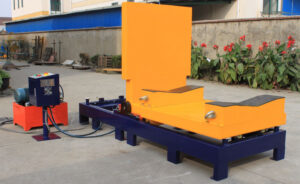
hydraulic tilter 3. Applications Across Industries and Core Benefits
Hydraulic tilters and upenders are versatile machines found in numerous sectors:
3.1. Common Industrial Applications
- Steel Processing & Distribution: Tilting steel coils from bore-vertical ("eye-to-the-sky") to bore-horizontal for slitting, processing, or shipping.
- Automotive Manufacturing: Handling large stamping dies, engine blocks, or chassis components.
- Paper Mills & Converting: Rotating heavy paper rolls.
- Tool & Die Shops: Manipulating large molds and dies for maintenance or setup.
- Heavy Fabrication & Assembly: Positioning large weldments or structures for optimal access.
- Shipping & Logistics: Preparing bulky items for transport or storage.
3.2. Key Advantages for Production Environments
Implementing hydraulic tilters/upenders offers significant benefits:
- Enhanced Safety: Dramatically reduces risks associated with manual handling or using less suitable equipment like cranes with slings for rotation. Prevents uncontrolled load movement.
- Improved Efficiency: Speeds up the repositioning process compared to manual methods, reducing cycle times and labor requirements.
- Product Protection: Smooth, controlled motion minimizes the risk of damage to valuable products like coils (telescoping, edge damage) or precision molds.
- Ergonomics: Eliminates strenuous manual tasks, reducing operator fatigue and the risk of musculoskeletal injuries.
- Versatility: Can be designed to handle a wide range of product weights, shapes, and sizes through customized platforms and fixtures.
4. Practical Considerations: Selection, Operation, and Maintenance
Successfully integrating and utilizing this equipment involves careful planning and ongoing attention.
4.1. Selecting the Right Hydraulic Tilter/Upender
Choosing the correct machine involves analyzing:
- Load Characteristics: Maximum weight, dimensions (L x W x H), center of gravity, and fragility.
- Process Requirements: Required tilt angle, cycle time frequency, integration with conveyors or AGVs.
- Operating Environment: Indoor/outdoor use, temperature extremes, presence of contaminants.
- Safety Standards: Compliance with local and industry-specific safety regulations.
Customization is often necessary to perfectly match the application needs.
4.2. Installation and Preventative Maintenance
Proper installation on a suitable foundation is crucial for stability and performance. Regular maintenance is key to longevity and safe operation:
- Hydraulic System: Check fluid levels and quality, inspect hoses and fittings for leaks or wear, change filters periodically.
- Mechanical Structure: Inspect welds, fasteners, and pivot points for fatigue or damage.
- Lubrication: Grease pivot points and bearings as per manufacturer recommendations.
- Safety Systems: Regularly test E-stops, limit switches, and hydraulic safety valves.
4.3. The Importance of Operator Training
Thorough training on the specific machine's operation, load securing procedures, safety features, and emergency protocols is essential for all operators to ensure safe and efficient use.

5. Seamless Integration into Production Lines
Hydraulic tilters and upenders are rarely standalone units. They are often integrated points within a larger production flow, receiving products from or feeding products to:
- Conveyor systems
- Automated Guided Vehicles (AGVs)
- Presses or processing machinery
- Packaging lines
- Storage racking
Properly planned integration ensures a smooth material flow, minimizing delays and maximizing the benefits of the tilting equipment. These machines are particularly crucial in steel coil handling operations to orient coils correctly for downstream processes. For specific examples focused on coil applications, see this resource detailing coil upenders.
6. Conclusion: Essential Tools for Modern Manufacturing
Hydraulic tilters and upenders are indispensable assets in industries dealing with heavy or unwieldy materials. By providing controlled, powerful, and precise rotation, they significantly enhance workplace safety, protect valuable products from damage, and improve overall operational efficiency. Careful selection based on specific application needs, proper installation, routine maintenance, and comprehensive operator training are key to maximizing the return on investment and ensuring the long-term reliability of this critical heavy load handling equipment.

